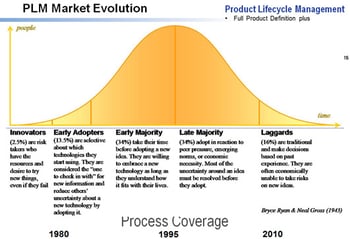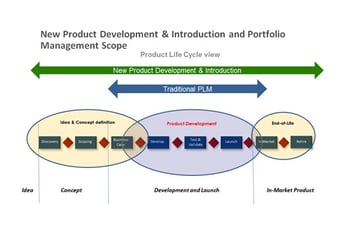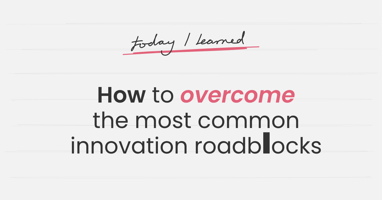In the early days of Product Data Management (PDM) systems through today's Product Lifecycle Management (PLM) systems, I have had the opportunity to participate in the evolution of improvement, realized business value and subsequent widespread PLM adoption among product development organizations. Much like the Diffusion of Innovation explains how, why, and at what rate new ideas and technology spread through cultures ( Fig. 1), the first PDM system in 1976 was an outcry of a need to track government contractors design work within NASA's IPAD (Integrated Programs for Aerospace-vehicle Design) project with Boeing as the prime sub-contractor.

At the time, it was common for large government procurements to be distributed among competitive contractors and since the “design data” for each product was on paper (which each contractor viewed as “their property”), the government had to pay each contractor to document the current state of the product AND the changes being done to the product. The obvious data redundancy was a huge issue for many areas of government including all sectors of the aerospace and defense contractor community which the IPAD project proposed to solve by “encouraging” digital data creation. Evolving from the need to share mechanical, electrical and all aspects of CAD/CAM engineering design data, early PDM systems used an external file vault to store the CAD files and a relational database management system to manage the “meta data”. For the first time, they were actually able to check in a CAD data file from one location, modify it in another location, and then retrieve the modified results at the original location. Over the ensuing three plus decades, this initial “engineering change management” system evolved to full BOM (bill of material) management, configuration management, and a full engineering lifecycle support system managing conceptual design through manufacturing, sustainability, and end of life product data (Fig. 2).

In contrast, in the early 1990's, R&D and product management organizations began to realize the enormous challenges associated with the business decisioning of prioritizing resources and investments across the various current and new product development initiatives. Capitalizing on the advances of CAD/CAM and PLM, product lifecycles were significantly reduced however these powerful new tools dramatically democratized the product development process. Commoditization and competition became more fierce and customers demanding and expecting more for less. Much as Moore's law describes the driving force of technological and social change in the semiconductor industry (and resulting products the past 48 years), Enterprise Innovation Performance (EIP, historically labeled PPM), is the new axiom with which CEO's and their boards are looking to drive organic growth and often survival in their businesses.
With an estimated 46% of the resources that companies devote to the conception, development and launch of new products and projects that do not succeed – failing in the marketplace or never making it to market became a one in two chance. Clearly a gap between automating the product development process and the product project business decisioning process became more apparent.
For most companies, product development meant line extensions, improvements, and product modifications, only serving to maintain market share. While project management tools existed to support multiple product projects, there was a workflow process gap in how these projects were prioritized to maximize the highest projected return on investment. With Stage-Gate® and other similarly gated process execution tools, a conceptual and operational road map for moving a new product project from idea to launch divided the effort into discrete stages and management decision gates. Gated process execution became the enabling process discipline for cross-functional teams to complete a prescribed set of related cross-functional activities in each stage prior to obtaining management approval to proceed to the next stage. 
Obviously it is critical to having a well-managed process for bringing new products to market and PLM is very useful in this regard. What is surprising however is how few companies actually understand and employ the same rigor and discipline with their new product development with complete visibility into their overarching portfolio value and financial optimization throughout their lifecycle ( Fig. 3).
Working with Stage-Gate International, Sopheon developed the first software implementation to automate the gated process methodology, rapidly becoming the de facto standard for new product business development and new product portfolio management.
Read my follow-up post about The Business Layer of PLM: The New Frontier in Business Value Optimization.







